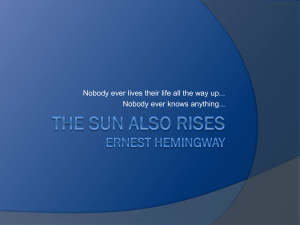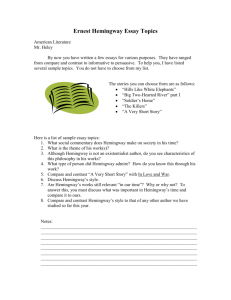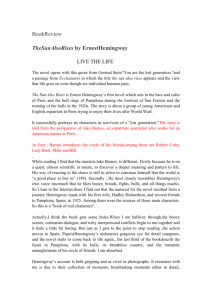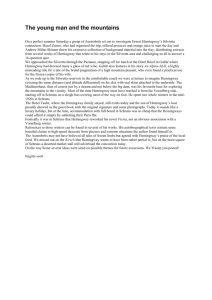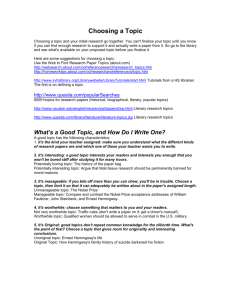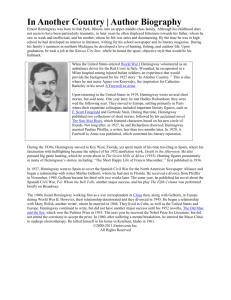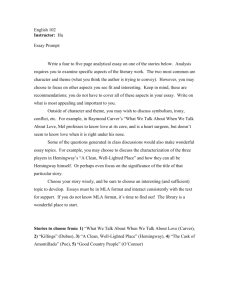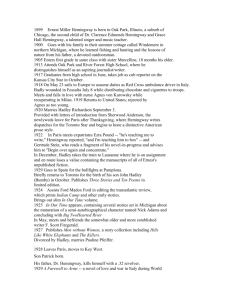research paper.doc
advertisement
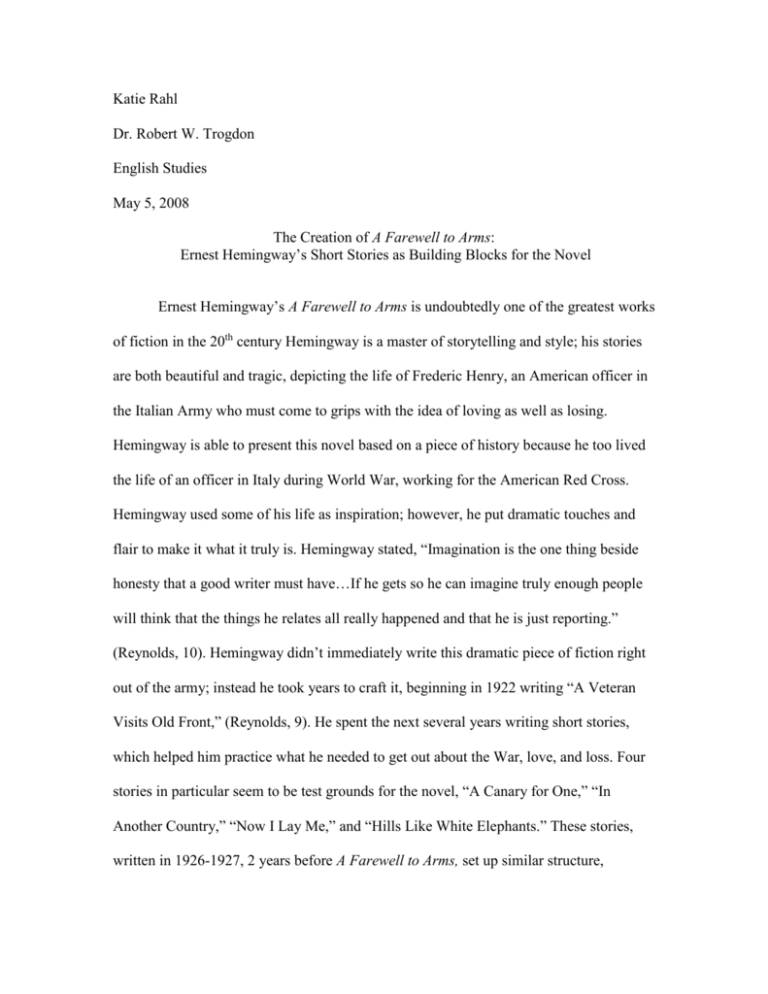
Katie Rahl Dr. Robert W. Trogdon English Studies May 5, 2008 The Creation of A Farewell to Arms: Ernest Hemingway’s Short Stories as Building Blocks for the Novel Ernest Hemingway’s A Farewell to Arms is undoubtedly one of the greatest works of fiction in the 20th century Hemingway is a master of storytelling and style; his stories are both beautiful and tragic, depicting the life of Frederic Henry, an American officer in the Italian Army who must come to grips with the idea of loving as well as losing. Hemingway is able to present this novel based on a piece of history because he too lived the life of an officer in Italy during World War, working for the American Red Cross. Hemingway used some of his life as inspiration; however, he put dramatic touches and flair to make it what it truly is. Hemingway stated, “Imagination is the one thing beside honesty that a good writer must have…If he gets so he can imagine truly enough people will think that the things he relates all really happened and that he is just reporting.” (Reynolds, 10). Hemingway didn’t immediately write this dramatic piece of fiction right out of the army; instead he took years to craft it, beginning in 1922 writing “A Veteran Visits Old Front,” (Reynolds, 9). He spent the next several years writing short stories, which helped him practice what he needed to get out about the War, love, and loss. Four stories in particular seem to be test grounds for the novel, “A Canary for One,” “In Another Country,” “Now I Lay Me,” and “Hills Like White Elephants.” These stories, written in 1926-1927, 2 years before A Farewell to Arms, set up similar structure, characters, images, and setting that led to the creation of the novel. The short stories helped Hemingway formulate his pattern for telling a story that closely related to his life. Throughout my research and readings, I will discuss how A Farwell to Arms was creating using the blue prints of four of Hemingway’s short stories. After reading A Farewell to Arms and several of Hemingway’s short stories, one begins to pick out similarities between them. Through researching Hemingway’s biography as well as the creation of his different stories, it easy to find where Hemingway jumped from short story to novel. To understand the creation of the short stories as well as the novel itself, one must understand a little bit about Hemingway’s life especially during his period in the war. After graduating from high school Hemingway become a reporter in Kansans City. In 1918, he enlisted in the American Red Cross as an ambulance driver on the Italian front. There, he was wounded, and while in the hospital in Milanand fell in love with an American nurse, Agnes Von Kurowsky. Agnes broke it off not long after, which devastated Hemingway and caused a lot of his inspiration in his work. After the war he married Hadley Richardson, and had a son, John. He then began a love affair with Pauline Pfeiffer, whom he later married in 1927. Her pregnancy and cesarean section was also inspiration for his writing, including in A Farewell to Arms (Beegel, 3). Throughout his two marriages, Hemingway found inspiration from his past and present to write short stories and work towards new novels. It is important to understand the time that each story was created as well as the details of it to find the connection of short story to novel. Between August and September of 1926, during his break up with first wife Hadley, Hemingway wrote “A Canary for One,” which was published in Scribners on November 11, 1926 (Justice, 31). The story then was published in his collection of short stories, Men Without Women, which ties into to all the short stories that lead up to and including A Farwell to Arms. The story, told in a first person point of view by the husband, is about the husband and his wife who are off to Paris to set up separate residences. While on the train, the wife strikes up a conversation with the American Lady about marriage, the love her daughter was forced to leave, and honeymoons. This story coincides with the life of Hadley and Ernest Hemingway; both were on a train to set up separate lives after Hadley found out he had been cheating on her with Pauline. The story is alive with vivid images of the train and the American lady whom the couple speaks to. Hemingway also uses beautiful metaphors with the train crash to represent the destruction of the marriage and their life together. “In Another Country,” was written around the same time, between September and November of 1926 (Smith, 164). This story was written in the midst of his divorce from Hadley and during his one hundred days without seeing Pauline. The story takes place in a hospital after the narrators knee had been hurt in the war. The story introduces us to the Major who is injured in more than just a physical way. Throughout the text the readers find the idea of pain, loss, and how one must carry on. During his writing of “In Another Country,” Hemingway wrote to F.Scott Fitzgerald telling him that “Our life has gone to hell which seems to be the one thing you can count on a good life to do.” (Smith, 164). He told Fitzgerald that he was writing another story about Italy, in particular Milan, which as we see later on becomes a primary focus of his war stories. “In Another Country” is a powerful story that shows the pain of war that affects soldiers on and off the battle grounds. The story shows that death makes no distinction and will hit everyone. This story is a learning ground for the narrator to learn about relationships from the Major who has been through it all. This story is part of Hemingway’s attempt to deal with the pain from his own experience in the war as well as the experience of divorce and loneliness. Next came what was almost the entitled, “In Another Country- Two,” because it was its sequel, but was switched to “Now I Lay Me,” (Smith, 172). The story was written between November and December of 1926, right after he finished “In Another Country.” This story too was published in the collection of Men Without Women. The story discusses the narrator, Nick Adams, insomnia during the war and the memories he thinks of from his childhood. He thinks back to his mother and fathers marriage and how his mother constantly emasculated his father. The story deals with the idea of love and marriage and how Nick is unsure of being married because of what he has seen in his past. Hemingway worked hard on this story, having four different manuscripts with small differences that he played with to change the story.
